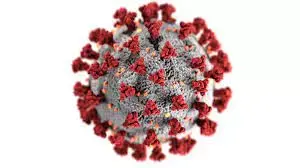Anyone who says covid doesn’t effect the immune system is a liar. All viruses take a toll on the immune system to some degree, and we can measure it after covid and it can be quite severe. Similar things happen after a flu. For a while after you will be more prone to opportunistic infections, like from bacteria and fungus and other viruses. Except most people only get the flu every several years, while covid can infect you several times a year due to being a coronavirus, being airborne and incredibly contagious, and mutating so quickly due to infecting so many hosts. Of course it’s making us sicker.
What they mean is “it’s not HIV”, but it’s also been shown, like other viruses, to persist in parts of people’s bodies, and while it’s not the same, long covid is effecting a lot of people in a similar way across the world. The pro-infection people are betting that covid was only dangerous because it was new to humanity, when signs are there that’s it’s still plenty dangerous even after previous exposure and vaccines.
“Dawn Bowdish, Canada Research Chair in Aging & Immunity at McMaster University, says they see immune changes following COVID infections in her lab. But she cautions against singling COVID out as uniquely disruptive.
“In our own work do we see that ‘COVID changes your immune system?’ Yes. But so does absolutely every other thing you’ve ever been exposed to,” she said. “Infections are never good for you.”
Subscribe to Professional Pulse. Receive our free quarterly newsletter featuring stories on workplace, industry and professional trends.
“Virtually every viral respiratory infection has this period where the immune responses needed to deal with the virus leave you compromised to bacterial infections,” she added.
Samira Jeimy, program director of Clinical Immunology and Allergy at Western University, says COVID’s disruptive effects on the immune system are probably driving recent illness surges.
“Other viruses cause immune dysregulation,” Jeimy said. “I don’t know why we’re in such denial that COVID can do it as well.”
“There’s still a pervasive belief that all of this is because of an ‘immunity [debt],’ which is hard to believe,” she said…
Raywat Deonandan, a University of Ottawa epidemiologist, said he is also “quite open” to the immunity theft hypothesis.
“We’re seeing rises in respiratory infections of all kinds,” he said. “And there’s probably something behind that.”


To be alive on this planet means we’re constantly in an evolutionary arms race to remain alive. Our adaptive immune response (T-Cells and B-Cells) was the answer evolutionary to mammalian viruses. Meaning, the “toll” our immune system takes is literally why we have it. From a virology and immunology standpoint, it’s understood viral infections lead to dysregulation as viruses are parasites with one goal, hijack our cellular machinery to reproduce. As far as opportunistic infections are concerned, that’s also in the same boat. The immune system is distracted, so it’s not as focused on playing defense. But, we’re all at risk of opportunistic infections simply by taking antibiotics, even with zero environmental influence. As far as comparing the mutation rates of influenza and coronaviruses, influenza wins hands down every time, it’s not even a competition. Influenza is a single stranded -RNA virus, while SARS-CoV-2 is a single stranded +RNA virus. So basically, out the gate, influenza has more opportunity to mutate as it’s required to bring its own polymerase to infect a host, while the other is ready to rock when it shows up. This provides a lot more opportunity for influenza mutations, no if, and, or buts. Additionally, both influenza and SARS-CoV-2 are enveloped respiratory viruses, so neither really has an edge here. Moreover, there is absolutely no question that when a virus first jumps species as a result of a mutation, it’s much more fatal. Yet, mutations are random, so it’s a role of the dice at best. Depending on the virus, a certain amount of the “offspring” will always be non-infectious because of this gamble. But a virus needs us, so killing us also kills it. This is why they’re more fatal when it initially jumps species. Lastly, persistent infections are seen in both SARS-CoV-2 and influenza. Granted, more so in the former, as influenza’s been around for ages, so our immune response is much more wise to its tactics. I don’t mean to talk down here at all, this is just a field I’m VERY familiar with, so I wanted to help you hone in your understanding on the topic!
My understanding is that the rate of mutation per infection for covid is not unusual, but the amount of people (and animals) it can infect, and how quickly it can infect them,is unusual, which is why we have been seeing covid mutate so rapidly.
A lot of the biggest mutations, like omicron, are believed to have come about as a result of long term infections in people with suppressed immune systems.
Well said! The aspects you highlighted here are great points to make when it comes down to the lab made conversation. If it was apples to apples regarding only mutation, I see SARS-CoV-2 having an edge. Yet, influenza has an ace up it’s sleeve known as reassortment. This compounds it’s already substantial mutation rate. Reassortment arises during the co-infection of different influenza viruses and produces novel variations 46%-86% of the time. Reassortment is attributed to influenza’s segmented RNA genome, which is a pretty rare trait across viruses. This is basically influenza’s mutation multiplier and keeps it ahead of the curve across the board.